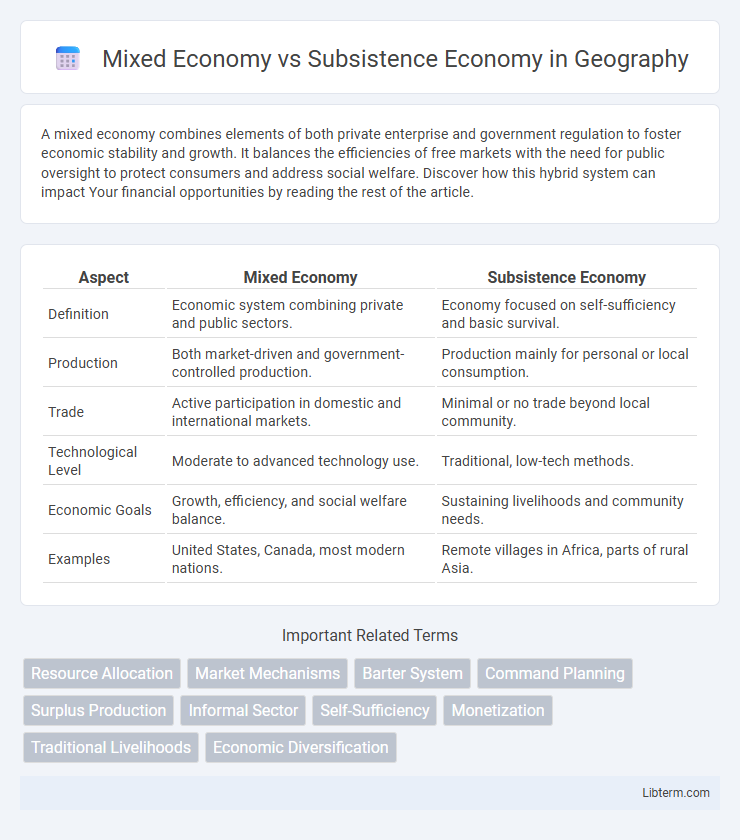A mixed economy combines elements of both private enterprise and government regulation to foster economic stability and growth. It balances the efficiencies of free markets with the need for public oversight to protect consumers and address social welfare. Discover how this hybrid system can impact Your financial opportunities by reading the rest of the article.
Table of Comparison
| Aspect | Mixed Economy | Subsistence Economy |
|---|---|---|
| Definition | Economic system combining private and public sectors. | Economy focused on self-sufficiency and basic survival. |
| Production | Both market-driven and government-controlled production. | Production mainly for personal or local consumption. |
| Trade | Active participation in domestic and international markets. | Minimal or no trade beyond local community. |
| Technological Level | Moderate to advanced technology use. | Traditional, low-tech methods. |
| Economic Goals | Growth, efficiency, and social welfare balance. | Sustaining livelihoods and community needs. |
| Examples | United States, Canada, most modern nations. | Remote villages in Africa, parts of rural Asia. |
Introduction to Economic Systems
A mixed economy combines elements of both market and command economies, allowing private enterprise to coexist with government intervention to regulate resources and promote social welfare. In contrast, a subsistence economy relies primarily on agriculture or barter systems, where communities produce just enough to meet their basic needs without significant surplus for trade or profit. Understanding these economic systems highlights the diversity in resource allocation, production methods, and socio-economic development across different societies.
Defining Mixed Economy
A mixed economy blends private enterprise with government intervention to balance economic efficiency and social welfare, incorporating elements of both capitalism and socialism. It allows market forces to guide production and consumption while the state regulates and provides public goods, ensuring equitable resource distribution. This contrasts with a subsistence economy, where individuals produce primarily for their own needs, with minimal market involvement and limited surplus for trade.
Understanding Subsistence Economy
A subsistence economy is characterized by self-sufficiency where communities produce goods primarily for their own consumption rather than for trade or profit. This economic system relies heavily on agriculture, hunting, and gathering, with limited use of money and markets. Unlike mixed economies that combine market-driven and government interventions, subsistence economies emphasize sustainability and the preservation of traditional practices.
Key Characteristics of Mixed Economy
A mixed economy combines elements of both private and public sectors, allowing for government intervention alongside free market principles to regulate economic activities and ensure social welfare. Key characteristics include the coexistence of private enterprise and public ownership, centralized planning in certain sectors, and a legal framework supporting property rights and market competition. This system aims to balance economic efficiency with social equity, addressing market failures while promoting sustainable growth.
Key Features of Subsistence Economy
Subsistence economy centers on self-sufficiency where households produce primarily for their own consumption with minimal surplus for trade, relying on traditional methods and local resources. It typically lacks formal markets, limited technological advancement, and low levels of specialization, emphasizing agriculture, hunting, and gathering. In contrast, a mixed economy combines private and public enterprises with market-driven production and government intervention, supporting broader economic growth and innovation.
Advantages of Mixed Economy
A mixed economy combines elements of both market and planned economies, allowing for efficient resource allocation and government intervention to correct market failures. It encourages innovation and competition while providing social welfare programs that reduce inequality and protect vulnerable populations. This economic system offers flexibility, balancing economic growth with social stability and sustainable development.
Benefits and Drawbacks of Subsistence Economy
A subsistence economy, characterized by self-sufficiency and minimal trade, benefits communities by ensuring basic needs are met through local resource use and traditional practices. However, it often limits economic growth, technological advancement, and access to broader markets, leading to vulnerability during environmental or social disruptions. Unlike mixed economies, which combine private enterprise with government regulation to promote innovation and stability, subsistence economies may struggle with poverty alleviation and infrastructure development.
Economic Growth and Development Comparison
Mixed economies combine market mechanisms with government intervention, fostering economic growth through diversified sectors and investment in infrastructure, technology, and social services. Subsistence economies, primarily based on self-sufficiency and minimal market exchange, experience limited economic growth due to low capital accumulation and restricted access to external markets. Consequently, mixed economies achieve higher levels of development with increased productivity and improved living standards, while subsistence economies often face stagnation and underdevelopment.
Real-World Examples of Both Economies
India exemplifies a mixed economy by integrating public sector enterprises with a strong private sector presence, balancing market freedom with government regulation to promote growth and social welfare. In contrast, many indigenous communities in the Amazon rainforest practice subsistence economies, relying on hunting, gathering, and small-scale agriculture to meet their immediate needs without surplus production. These examples highlight the mixed economy's role in complex national development versus the subsistence economy's focus on sustainable, localized resource use for survival.
Conclusion: Choosing the Right Economic System
Selecting the appropriate economic system depends on a society's development goals, resource availability, and social priorities. A mixed economy balances market freedom with government intervention, promoting growth and social welfare, while a subsistence economy emphasizes self-sufficiency and sustainability in resource-limited environments. Understanding these distinct frameworks enables informed decisions that align economic structures with cultural values and long-term prosperity.
Mixed Economy Infographic

 libterm.com
libterm.com